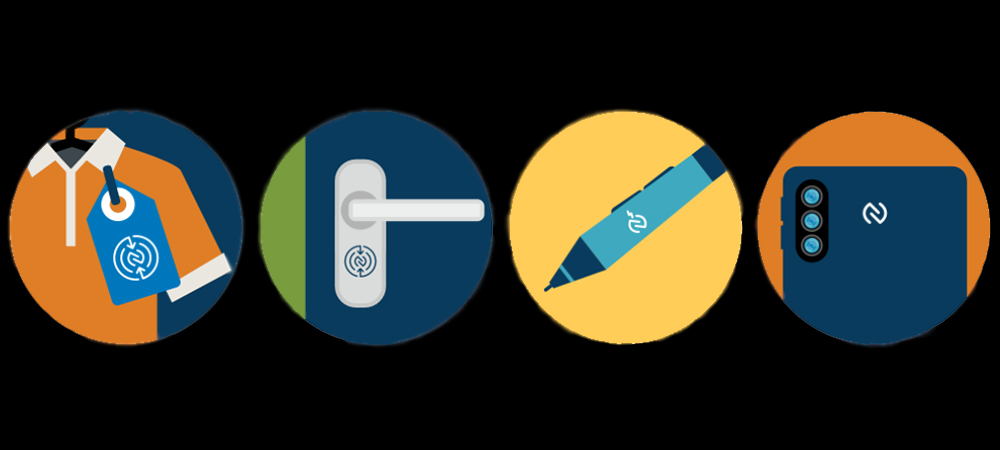The NFC Forum has released a new icon it calls the Wayfinding Mark, which is intended to improve Near Field Communication (NFC) technology user experiences and increase interoperability. The organization released the new mark in November 2021, while in recent months it has organized and grown to meet the latest evolution in NFC technology use. New members, rule changes and interoperability testing are all expected to enable more global efforts for digital wallets and other contactless systems.
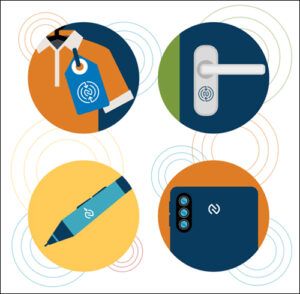
Example uses of the new Wayfinding Mark
The Wayfinding Mark, approved by the NFC Forum’s executive board, was designed to provide a universal guide for NFC users that will help bring together what has become a fragmented market, according to Mike McCamon, the NFC Forum’s executive director. NFC technology is being used for electronic contactless payments, car door access and stylus connections, as well as on consumer goods labels, for product content and authentication, among other applications. Despite its presence in many facets of everyday life, consumers might not easily recognize the technology. In fact, the NFC Forum has found that one third of all people do not know where to tap their smartphones to accomplish an NFC transaction.
In part, that has to do with a lack of recognizable indicators. Currently, there are dozens of different NFC icons in use in the market, including multiple versions of the NFC Forum’s N-Mark, that indicate the presence of an NFC transponder. The three-wave code for electronic payments may be the most recognizable, but that is limited to payment applications. The lack of recognizable icons can reduce adoption rates, McCamon says, because unlike other wireless technologies, 13.56 MHz NFC compliant with the ISO 14443 standard does not operate without some effort on the part of users. Individuals might not realize the technology they use to open car doors via their phones is the same as that which identifies information about groceries.
As a result, they might not end up using the NFC technology, because while other solutions broadcast their presence without requiring any action, NFC users must make a deliberate effort to take advantage of the technology—and they require instructions to accomplish this. With this challenge in mind, a workgroup of approximately 20 NFC Forum members led the effort to create the mark. The workgroup created what they hope is a recognizable logo that could be easily differentiated from other markers, such as those for Wi-Fi.
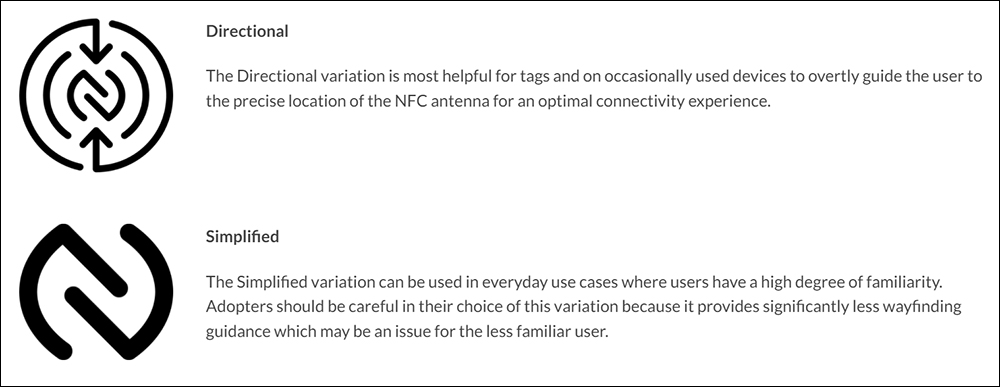
The new version consists of four related icons, and the one expected to be used most commonly consists of an abstract circular antenna design, with arrows serving as a visual pointer for where to tap. A simplified version gives no visual tap cues, while an instructional version includes a hand with a phone tapping the logo. The fourth version includes a lightning bolt symbol to signify charging capability. The new logo is intended to be evocative of the old N-Mark, McCamon says. It looks like a handshake, he adds, and includes waves to resemble the contactless payment waves used by payment terminals.
The marker comes with other changes for NFC developers. The traditional N-Mark logos all included an NDEF requirement, which meant that to use the logo, the system had to employ an NDEF record to enabled connectivity with a website URL. Thus, users tapping the logo would then be connected directly to a specific website. Multiple NDEF records can be encoded on a tag so that one launches an application on the phone first, then the second could bring users directly to a specified URL if there is no app response. By removing the NDEF requirement with the new marker, McCamon explains, the NFC Forum aims to open developers up to options for NFC that were previously hard to implement.
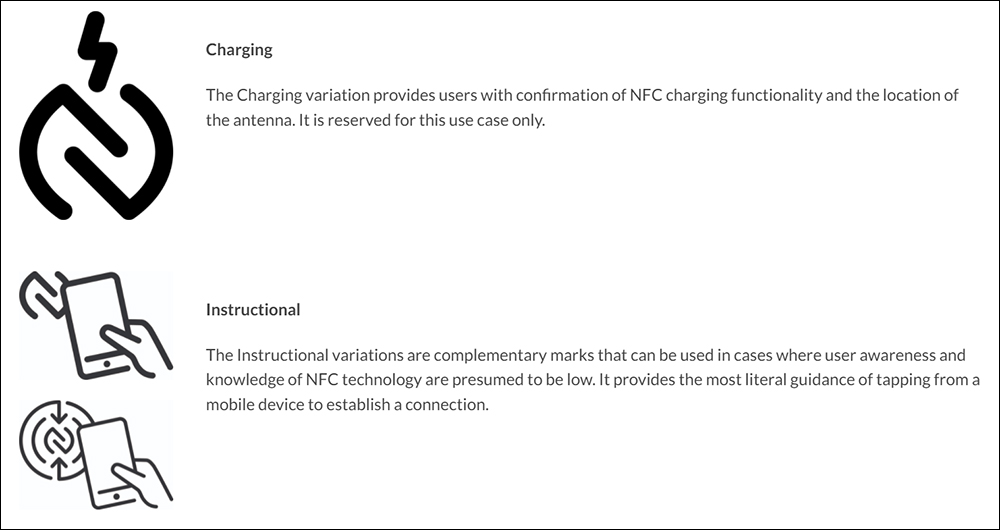
To date, approximately 1,400 licensees of the N-Mark certification have been using the NDEF record. Once the Wayfinding Mark is commonly adopted, McCamon says, the NFC Forum expects to see it displayed on product price labels, on doorways, on a stylus or as a sticker on a smartphone, until handset manufacturers adopt the logo and display it on handset screens along with traditional Bluetooth, Wi-Fi and power symbols. It will take some time for the marks to be adopted, he notes. “We’re going to make a pretty big effort in Q1 to do quite a bit of aggressive marketing.” Meanwhile, the N-Mark continues to be used globally by companies that have already adopted it.
Eventually, McCamon hopes consumers will see a less fragmented market. “We can’t have a continuation of various markers,” he states. “Now that we have something universal, we can encourage companies to migrate away from proprietary markers.” Once the same logo appears on a wide variety of products and devices, he explains, the NFC Forum hopes consumers will become as familiar with the technology as they are with Bluetooth. Then, he predicts, people will be able to say, “Oh, this is just like my car—if I tap this, something will happen.”

Mike McCamon
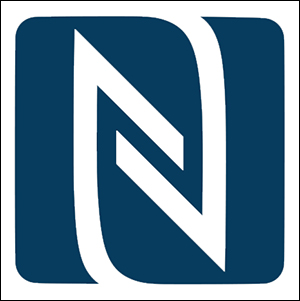
The N-Mark
There are some other changes underway at the NFC Forum as well, McCamon says. For instance, Huawei—which designs and manufactures consumer electronics, including mobile phones—joined the organization late last year and now has a representative on the board of directors. This year, the Forum became a Voluntary Consensus Standards Body to help plan, develop, establish and coordinate voluntary consensus standards using agreed-upon procedures. Other board members include representatives from Google, Apple and Sony, indicating support from large handset and device makers. According to McCamon, there were no dissenting votes on the new logo.
In addition, the NFC Forum intends to provide an interoperability testing system for the Car Connectivity Consortium, known as Certification Release CR13, so that NFC technology will become a standard part of testing for automotive digital keys. The Consortium has mandated Near Field Communication in digital keys for new cars because NFC enables phones to operate as transponders, even if their power has run out or if they are in “no power” state. Other technologies, such as ultra-wideband, require a charged phone to operate properly.
The NFC Forum is currently working with the Universal Stylus Initiative on a standard for universal stylus digital pens. Users would be able to buy a single stylus, McCamon explains, and use it with multiple devices. Changes are coming at an appropriate time, he says, noting that the COVID-19 pandemic has led to a surge in contactless applications.
Images: NFC Forum

